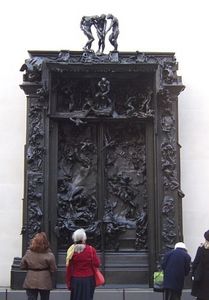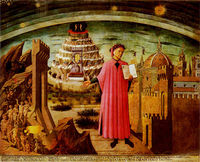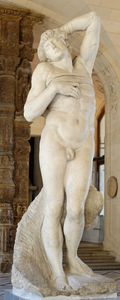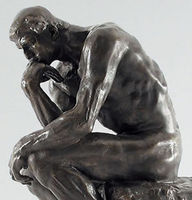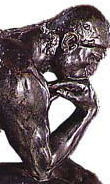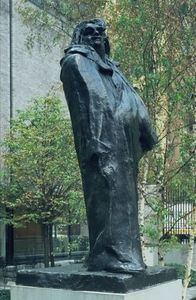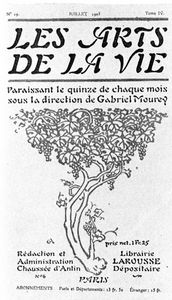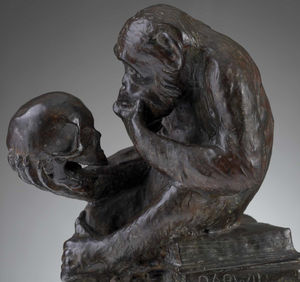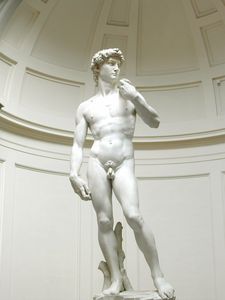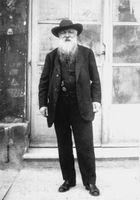The Thinker
- Date of Creation:
- 1881
- Height (cm):
- 71.50
- Length (cm):
- 58.00
- Width (cm):
- 40.00
- Medium:
- Metal
- Subject:
- Figure
- Art Movement:
- Impressionism
- Created By:
- Current Location:
- Paris, France
- Displayed at:
- Musée Rodin
- Owner:
- Musée Rodin
The Thinker Story / Theme
The Thinker was originally part of the compositional piece Rodin created as an entranceway for the proposed Musée des Arts Décoratifs in Paris. This piece, known as The Gates of Hell, is based on the 16th century epic poem, The Divine Comedy by Dante.
Many of Rodin's most famous works came out of this piece and The Thinker was originally intended to sit at the top of the door way and represent Dante, as he composed the poem. For this reason The Thinker was originally known as The Poet but as this piece began to gain precedence over The Gates of Hell, it became known as The Thinker and is today a commonly recognized symbol of philosophy and learning.
During its use as a public monument in Paris from 1906 onwards, The Thinker became known as a symbol of the socialist movement in France during a time of political and social turmoil.
The Thinker Inspirations
There are several inspirations which influenced Rodin's creation of The Thinker. The foremost must be the work of Dante, the poet whom the figure was originally supposed to represent. Stylistically the sculpture resembles the heroes of Michelangelo and the nude young men whom Rodin felt best to represent in a romantic and creative light.
Dante Alighieri:
Dante Alighieri wrote his epic poem The Divine Comedy between 1308 and 1321 and since its publication the literary work has served as inspiration for countless arts, writers and sculptors.
The Divine Comedy follows a dream in which the author enters the after-life. Dante describes three different states, Hell, Purgatory and Paradise. This work consumed most of Dante's life and he died the year it was completed. The popularity of the poem at the end of the 19th century could well have been the reason Rodin chose this subject as the theme of many of his sculptures, including The Thinker and The Kiss.
Michelangelo:
Rodin presented The Thinker nude as with many of his works and the similarities between this type of style and that of Renaissance masters such as Michelangelo is clear to see. To Rodin there was something poetic about the heroic nude and that type of heresy and romanticism was what the artist wanted to capture in his sculpture.
Hugo Rheinhold:
Hugo Rheinhold was a contemporary of Rodin and an Impressionist sculptor from Germany. Rheinhold produced and exhibited his Affe mit Schadel before The Thinker was created and this work may well have influenced Rodin. Both artists shared an appreciation of natural, realistic compositions.
The Thinker Analysis
As one of Auguste Rodin's most recognized works The Thinker is surprisingly simple in design and is possibly one of the easiest of Rodin's pieces to understand.
Subject Matter:
Originally supposed to represent Dante, the poet, once this piece was enlarged and created as a sculpture within its own right the meaning behind it became more ambiguous. Commonly thought to represent knowledge or the attainment of knowledge, Rodin himself always referred to this piece as The Poet.
Composition:
The position which the contemplative figure finds himself in is one of deep thought and concentration. The arched back and curled hand resting under the chin are signs of study that would have been hard to capture were this figure standing up. This also allows for the figure's muscular back and broad shoulders to be fully defined, the powerful physique of the sitter reflecting the high esteem in which Rodin held poets like Dante.
Tone and Mood elicited:
The mood of this piece is one of calm. Rodin captures the very human emotion of The Thinker which may go some way as to explain how this piece became one of the artist's most famous works.
Methods:
Although Rodin often used a model for many of his pieces it is not known if this was the case for The Thinker. Due to the numerous figures that Rodin had to compose for The Gates of Hell, The Thinker may have been a culmination of early sketches in which models sat in numerous poses.
Once Rodin had decided on this position for The Thinker he would have made preliminary models from clay on a small scale. One of the artist's assistants would have then begun to carve the full-size model under his supervision. The artist was known to put the final touches to many of his carved pieces once the basic figure had been created by an assistant.
The Thinker Critical Reception
Unfortunately the Paris Museum for which the original The Gates of Hell was created was never built and so there is little critical reception for this piece in its original format. However, when Rodin chose to create The Thinker as a single sculpture it became one of his most well-known and acclaimed works. A copy of the piece was in fact chosen by the artist to mark his grave in the cemetery at Meudon in Paris, France.
Reception during the artist's Lifetime:
The Thinker was first exhibited as a large-scale individual sculpture in 1904 at the Salon in Paris. The reaction to this piece was unprecedented and it became a favorite of the press at that time. Due to the fact that long before The Thinker was exhibited critics had been ridiculing Rodin's Monument to Balzac in the same gallery, one critic in particular felt that The Thinker more than made up for the abstract and unusual Balzac.
Gabriel Mourey was the editor of a magazine called "Les Arts de la vie", which was a popular art publication of the time. Mourey started a subscription for The Thinker so that it could be purchased for the people of Paris to enjoy. By doing this, the memory of Rodin's disastrous Monument to Balzac was largely forgotten and Rodin cemented his place as the most influential sculptor of modern times.
After the Artist's Death:
Although some of Rodin's work fell out of favor as the 20th century progressed, The Thinker has remained one of the his most popular works. Some critics have noted that this could be because The Thinker relates to everyone and the very human nature of the piece is much easier to understand than some of Rodin's more abstract works.
21st Century:
Today the amount of copies of The Thinker around the world is testament to its popularity. Often used in many satirical comedies, The Thinker is such an iconic piece of work that it is still inspiring artists to this day.
The Thinker Related Sculptures
The Thinker Locations Through Time - Notable Sales
The original marble copy of The Thinker currently resides in the Musee Rodin in Paris, France. The piece was moved to the museum after Rodin's death when his whole estate was given to the French Government. As with many popular sculptures, several casts of the original work have been made and can now be found in cities all over the world.
In June 2009 a bronze version of The Thinker was sold under auction for three million Euros at the Drouot auction house, in Paris. This unprecedented amount was a big sale for a sculpture which only stood at 72.5 centimeters high.
The Thinker Artist
Auguste Rodin was a prolific artist and one who was widely acclaimed throughout his lifetime. Born in humble beginnings, The Thinker was part of one of his first civic commissions, The Gates of Hell. The Thinker itself was turned into an individual sculpture in 1902 and during this period Rodin was beginning to be a truly successful artist.
During The Thinker's first exhibition in 1904 critics were so enthralled by the piece that it became Rodin's first work to be erected in a public place. This was after a campaign by Gabriel Mourey, editor of the magazine Les Arts de la vie, which raised funds for a new copy of the piece to be commissioned.
By 1906 the second copy of The Thinker was erected in front of the Parthenon in Paris during a period of great political and social tensions. The Thinker became a symbol of the socialist movement in France during this time.
The Thinker Art Period
Auguste Rodin was at the forefront of Impressionist sculpture and yet the artist never really connected himself with the other artists of the movement. Rodin never showed his work under the title of Impressionism and therefore it is hard to associate him with this art movement.
The work of Rodin has remained some of the most innovative and ground-breaking of any sculptor in the history of art. Such was his impact that Rodin's work is often classified as Impressionist simply because it rebelled against the academic and classical ideals, as many Impressionist artists did through painting.
The Thinker Bibliography
Below is a list of internet and literary sources that offer more in-depth information about Rodin's The Thinker.
Books:
• Callen, Anthea. The Spectacular Body: Science, Method and Meaning in the Work of Degas. New Haven and London: Yale University Press, 1995
• Barbier, Nicolle. Marbres de Rodin: collection du musée. Paris, 1987: 184-187
• Barbier, Nicolle. Rodin sculpteur: Oeuvres méconnues. Exh. cat. Musée Rodin, Paris, 1992: 187-190
• Elsen, Albert, E. Rodin's Gates of Hell. University of Minnesota, 1960
• Hawkins, Jennifer. Rodin Sculptures. VAM HMSO, London, 1975
• Kausch, Michael. Auguste Rodin: Eros und Leidenschaft. Exh. cat. Harrach Palace, Kunsthistorisches Museum
• Lawton, Frederick. The Life and Work of Auguste Rodin. London, 1906
• Mitchell, Claudine. Rodin the Zola of Sculpture. Ashgate Publishing Ltd, 2004
• Rosenfeld, Daniel. "Rodin's Carved Sculpture. " In Rodin Rediscovered. Exh. cat. National Gallery of Art, Washington, D. C., 1981: 85-87
Web Sources:
http://www.musee-rodin.fr/welcome.htm


